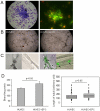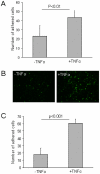Successful in vitro expansion and differentiation of cord blood derived CD34+ cells into early endothelial progenitor cells reveals highly differential gene expression
- PMID: 21858032
- PMCID: PMC3155543
- DOI: 10.1371/journal.pone.0023210
Successful in vitro expansion and differentiation of cord blood derived CD34+ cells into early endothelial progenitor cells reveals highly differential gene expression
Abstract
Endothelial progenitor cells (EPCs) can be purified from peripheral blood, bone marrow or cord blood and are typically defined by a limited number of cell surface markers and a few functional tests. A detailed in vitro characterization is often restricted by the low cell numbers of circulating EPCs. Therefore in vitro culturing and expansion methods are applied, which allow at least distinguishing two different types of EPCs, early and late EPCs. Herein, we describe an in vitro culture technique with the aim to generate high numbers of phenotypically, functionally and genetically defined early EPCs from human cord blood. Characterization of EPCs was done by flow cytometry, immunofluorescence microscopy, colony forming unit (CFU) assay and endothelial tube formation assay. There was an average 48-fold increase in EPC numbers. EPCs expressed VEGFR-2, CD144, CD18, and CD61, and were positive for acetylated LDL uptake and ulex lectin binding. The cells stimulated endothelial tube formation only in co-cultures with mature endothelial cells and formed CFUs. Microarray analysis revealed highly up-regulated genes, including LL-37 (CAMP), PDK4, and alpha-2-macroglobulin. In addition, genes known to be associated with cardioprotective (GDF15) or pro-angiogenic (galectin-3) properties were also significantly up-regulated after a 72 h differentiation period on fibronectin. We present a novel method that allows to generate high numbers of phenotypically, functionally and genetically characterized early EPCs. Furthermore, we identified several genes newly linked to EPC differentiation, among them LL-37 (CAMP) was the most up-regulated gene.
Conflict of interest statement
Figures







Similar articles
-
Human cord blood-derived AC133+ progenitor cells preserve endothelial progenitor characteristics after long term in vitro expansion.PLoS One. 2010 Feb 11;5(2):e9173. doi: 10.1371/journal.pone.0009173. PLoS One. 2010. PMID: 20161785 Free PMC article.
-
Immunological and ultrastructural characterization of endothelial cell cultures differentiated from human cord blood derived endothelial progenitor cells.Histochem Cell Biol. 2006 Dec;126(6):649-64. doi: 10.1007/s00418-006-0201-6. Epub 2006 Jun 10. Histochem Cell Biol. 2006. PMID: 16767408
-
Human umbilical cord blood-derived CD34-positive endothelial progenitor cells stimulate osteoblastic differentiation of cultured human periosteal-derived osteoblasts.Tissue Eng Part A. 2014 Mar;20(5-6):940-53. doi: 10.1089/ten.TEA.2013.0329. Epub 2013 Dec 3. Tissue Eng Part A. 2014. PMID: 24168264
-
Circulating endothelial progenitor cells and diseases of the preterm infant.Minerva Pediatr. 2010 Jun;62(3 Suppl 1):21-3. Minerva Pediatr. 2010. PMID: 21089713 Review.
-
Endothelial progenitor cells in angiogenesis.Sheng Li Xue Bao. 2005 Feb 25;57(1):1-6. Sheng Li Xue Bao. 2005. PMID: 15719128 Review.
Cited by
-
Circulating and tissue resident endothelial progenitor cells.J Cell Physiol. 2014 Jan;229(1):10-6. doi: 10.1002/jcp.24423. J Cell Physiol. 2014. PMID: 23794280 Free PMC article. Review.
-
Single-Cell RNA Sequencing of Human Embryonic Stem Cell Differentiation Delineates Adverse Effects of Nicotine on Embryonic Development.Stem Cell Reports. 2019 Apr 9;12(4):772-786. doi: 10.1016/j.stemcr.2019.01.022. Epub 2019 Feb 28. Stem Cell Reports. 2019. PMID: 30827876 Free PMC article.
-
Endothelial colony-forming cells and pro-angiogenic cells: clarifying definitions and their potential role in mitigating acute kidney injury.Acta Physiol (Oxf). 2018 Feb;222(2):10.1111/apha.12914. doi: 10.1111/apha.12914. Epub 2017 Jul 25. Acta Physiol (Oxf). 2018. PMID: 28656611 Free PMC article. Review.
-
Galectins in Endothelial Cell Biology and Angiogenesis: The Basics.Biomolecules. 2021 Sep 20;11(9):1386. doi: 10.3390/biom11091386. Biomolecules. 2021. PMID: 34572599 Free PMC article. Review.
-
Interaction between Galectin-3 and Integrins Mediates Cell-Matrix Adhesion in Endothelial Cells and Mesenchymal Stem Cells.Int J Mol Sci. 2021 May 13;22(10):5144. doi: 10.3390/ijms22105144. Int J Mol Sci. 2021. PMID: 34067978 Free PMC article.
References
-
- Asahara T, Murohara T, Sullivan A, Silver M, van der Zee R, et al. Isolation of putative progenitor endothelial cells for angiogenesis. Science. 1997;275:964–967. - PubMed
-
- Dimmeler S. Regulation of bone marrow-derived vascular progenitor cell mobilization and maintenance. Arterioscler Thromb Vasc Biol. 2010;30:1088–1093. - PubMed
-
- Hristov M, Erl W, Weber PC. Endothelial progenitor cells: mobilization, differentiation, and homing. Arterioscler Thromb Vasc Biol. 2003;23:1185–1189. - PubMed
Publication types
MeSH terms
Substances
LinkOut - more resources
Full Text Sources
Medical

